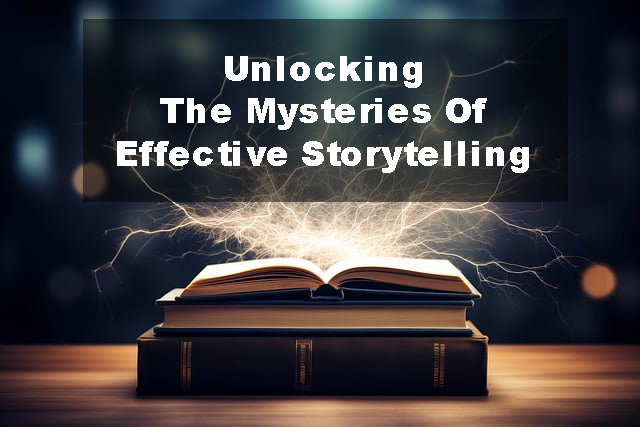In the vast landscape of content creation, storytelling stands as an ancient and enduring art form.
From the earliest cave paintings to the latest blockbuster films, stories have:
- Captivated
- Entertained
- And enlightened humanity.
Yet, despite its timeless appeal, few manage to get it right.
What are the secrets behind crafting compelling narratives that resonate with audiences across time and space?
In this exploration, we uncover the hidden gems that unlock the mysteries of effective storytelling.
The Power of Narrative
At its core, storytelling is the art of communication, a vehicle through which:
- Ideas
- Emotions
- And experiences are shared.
From the epic tales of ancient civilizations to the intimate anecdotes exchanged between friends, narratives shape our understanding of the world and ourselves.
But what makes a story compelling?
The answer lies in the ability to connect with the audience on a visceral level, to:
- Evoke emotions
- Provoke thoughts
- And inspire action.
The Elements of Storytelling
Like the ingredients of a recipe, storytelling relies on a blend of essential elements to create a cohesive and engaging narrative.
These elements include:
- Character: The heart and soul of any story, characters breathe life into the narrative, serving as vessels through which the audience experiences the journey. Whether heroes, villains, or everyday people, compelling characters possess depth, complexity, and relatability.
- Plot: The sequence of events that drives the story forward, the plot provides structure and momentum, keeping the audience engaged from beginning to end. From the inciting incident to the climax and resolution, a well-crafted plot unfolds with purpose and coherence.
- Setting: The backdrop against which the story unfolds, setting establishes the time, place, and atmosphere of the narrative. Whether fantastical worlds or mundane realities, immersive settings transport the audience to new realms of imagination.
- Conflict: The driving force behind every story, conflict creates tension, drama, and stakes, propelling the characters towards their goals while testing their resolve and resilience. From internal struggles to external obstacles, compelling conflict fuels the narrative engine.
- Theme: The underlying message or moral of the story, theme provides depth and resonance, inviting the audience to ponder deeper questions about life, society, and the human condition. Whether love, justice, or redemption, timeless themes transcend the boundaries of time and culture.
Crafting Compelling Narratives
While the elements of storytelling provide a framework for crafting narratives, the art lies in their execution.
Here are some key principles to keep in mind when crafting compelling stories:
- Know Your Audience: Understanding the desires, fears, and aspirations of your audience is essential for creating stories that resonate. Tailor your narrative to their interests and sensibilities, ensuring maximum impact and engagement.
- Create Compelling Characters: Invest time and effort in developing well-rounded characters with distinct personalities, motivations, and arcs. Make them relatable, flawed, and ultimately human, allowing the audience to empathize with their struggles and triumphs.
- Build Tension and Suspense: Keep the audience on the edge of their seats by introducing conflict, obstacles, and twists that raise the stakes and deepen the intrigue. Use pacing, foreshadowing, and dramatic irony to maintain suspense and drive the narrative forward.
- Show, Don’t Tell: Instead of simply telling the audience what happens, show it through vivid descriptions, evocative imagery, and immersive details. Engage the senses and emotions of the audience, allowing them to experience the story firsthand.
- Embrace the Power of Emotion: Touch the hearts of your audience by tapping into universal emotions such as love, fear, joy, and sorrow. Create moments of genuine emotional resonance that linger long after the story ends, forging a lasting connection with the audience.
The Evolution of Storytelling in the Digital Age
In today’s digital age, storytelling has undergone a profound transformation, adapting to new:
- Mediums
- Tech
- And platforms.
From the rise of social media and streaming services to the emergence of virtual reality and interactive storytelling, the possibilities are greater than ever before.
Yet, amidst this sea of change, the fundamentals of effective storytelling remain unchanged.
Whether through a 280-character tweet or a feature-length film, the power of a well-crafted story to:
- Inform
- Inspire
- And entertain endures.
Conclusion: The Endless Quest for Meaning
As we conclude our journey through this labyrinth, one thing becomes clear:
Storytelling is:
- Both an art and a science
- A journey of discovery
- And a quest for meaning.
Whether weaving tales around a campfire or crafting multimedia experiences for global audiences, storytellers hold the keys to unlocking the mysteries of the human experience.
So let us continue to explore, to experiment, and to push the boundaries of storytelling, for in the end, the greatest stories are yet to be told.
You May Also Like:
The East India Company: Lessons From A Colossus of Commerce and Empire
5 Essential Steps To Online Business Success
Life Goes On
25 Cognitive Biases To Account For
I Will Show You How To Start Building A Brand - As Professionals Do
The Surprising Truth About Market Saturation
The X Factor in Communication: Why Trust Outweighs Content
Surviving The Mafia: Life Lessons From Michael Franzese
My name is Mister Infinite. I've written 600+ articles for people who want more out of life. Within this website you will find the motivation and action steps to live a better lifestyle.


